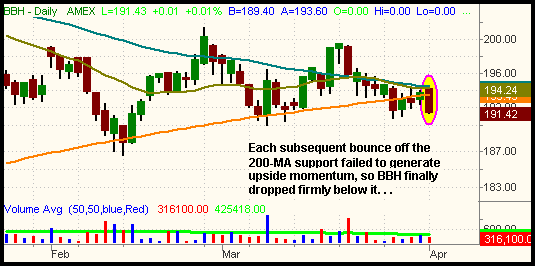3 ETFs that could go higher
Stocks began the second quarter on a positive note, but reversed at mid-day and closed mostly lower. By mid-day, the Nasdaq Composite had rallied 0.8% to a new five-year high on an intraday basis, but it rapidly reversed in the afternoon and finished the day 0.1% lower and near the bottom of the previous day’s range. The S&P 500 and Dow Jones Industrial Average each gave back substantial gains as well, but both indices secured marginal advances of 0.2% and 0.3% respectively. The small-cap Russell 2000 Index took a rest by closing 0.8% lower, while the S&P Midcap 400 Index lost 0.1%.
Total volume in the Nasdaq was 4% higher than the previous
day’s level, which gave the index a bearish “distribution day.” A 2% drop in the
NYSE volume level prevented the S&P from registering a “distribution day” as
well, although the intraday action was negative nevertheless. Declining volume
exceeded advancing volume by a margin of 3 to 2 in the Nasdaq, but the NYSE
volume ratio was positive by the same margin.
Due to relative weakness in the Biotech Index
(
BTK |
Quote |
Chart |
News |
PowerRating), we alerted regular
subscribers that we sold short the Biotech HOLDR
(
BBH |
Quote |
Chart |
News |
PowerRating) when it fell below support of its 200-day moving average yesterday. As you may recall, we have been stalking BBH for a potential short entry ever since it first touched support of its 200-day MA on February 10. When an ETF first drops to its 200-MA, rarely will it fall through it without first bouncing off it. However, if the retracement fails to gain upward momentum, the 200-MA will act like a magnet that causes the ETF to re-test that support level a short time later. Each subsequent test of the 200-MA support increases the odds of it finally breaking through, which will inevitably occur if the ETF does not eventually establish a new uptrend off the 200-MA support. When an ETF breaks the 200-MA with a confirmed downward thrust, it often presents a low-risk short sale entry point. Looking at the daily chart of BBH below, notice how each bounce off the 200-MA was smaller and smaller until it eventually fell through. The 20 and 50-day MAs now provide overhead resistance as well:

As of yesterday’s close, our new short position is showing a marked-to-market gain of just over a point. Our first profit target is the February low around the $187 area. At that point, we will re-assess the price action of BBH and trail the stop lower in anticipation of possible further downside. If the February low is broken, the next area of major support is the October 2005 low just below $181. In case of reversal, our protective stop is above convergence of the 20 and 50-day moving averages.
If looking for potential long entries, you might consider some of the international ETFs that have been showing relative strength to the U.S. markets, especially the Asian markets.
(
FXI |
Quote |
Chart |
News |
PowerRating) (iShares Xinhua China 25) gapped up to fresh record high, while both
(
EWJ |
Quote |
Chart |
News |
PowerRating) (iShares Japan) and
(
EWH |
Quote |
Chart |
News |
PowerRating) (iShares Hong Kong) closed at a new five-year high. Within the U.S. markets, the StreetTRACKS
Gold Trust
(
GLD |
Quote |
Chart |
News |
PowerRating) continues to consolidate at its new all-time high it
finished at last week. The Oil Service HOLDR
(
OIH |
Quote |
Chart |
News |
PowerRating) initially looked pretty good when it broke out above its 50-day MA last week, but its action over the past two days has been a bit indecisive. Use caution if long OIH or other oil-related issues.
In the March 3 issue of The Wagner Daily, we extensively discussed the current support levels in the major indices. Because of yesterday’s bearish intraday reversal, there is a strong possibility the major indices will test those support levels within the next several days. To refresh your mind, we’re keeping a watchful eye on support of the primary uptrend lines on both the S&P 500 and Dow Jones Industrials. Those trendlines roughly converge with their respective 50-day moving averages. The Nasdaq Composite, which we warned only finished last week above its prior high by eight points, closed yesterday right at that support level. A firm close below yesterday’s low will provide a warning sign that the breakout to a new five-year high is in danger of failing.
Open ETF positions:
Short BBH (regular subscribers to The Wagner Daily receive detailed stop and target prices on open positions and detailed setup information on new ETF trade entry prices. Intraday e-mail alerts are also sent as needed.)
Deron Wagner is the head trader of Morpheus Capital Hedge Fund and founder of Morpheus Trading Group (morpheustrading.com), which he launched in 2001. Wagner appears on his best-selling video, Sector Trading Strategies (Marketplace Books, June 2002), and is co-author of both The Long-Term Day Trader (Career Press, April 2000) and The After-Hours Trader (McGraw Hill, August 2000). Past television appearances include CNBC, ABC, and Yahoo! FinanceVision. He is also a frequent guest speaker at various trading and financial conferences around the world. For a free trial to the full version of The Wagner Daily or to learn about Deron’s other services, visit morpheustrading.com or send an e-mail to deron@morpheustrading.com.
